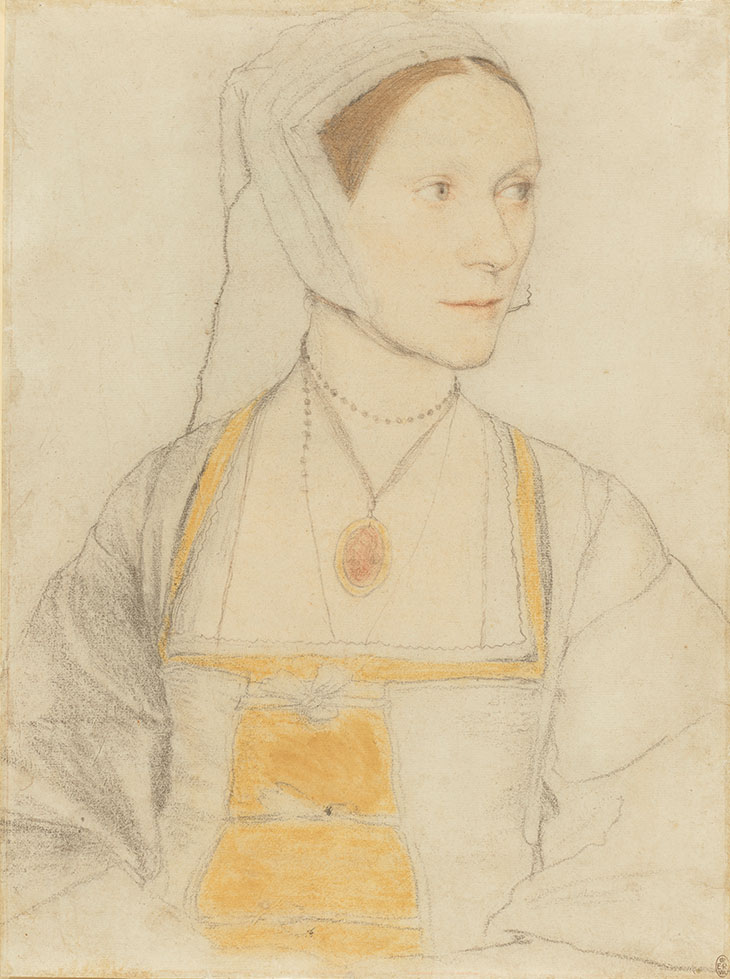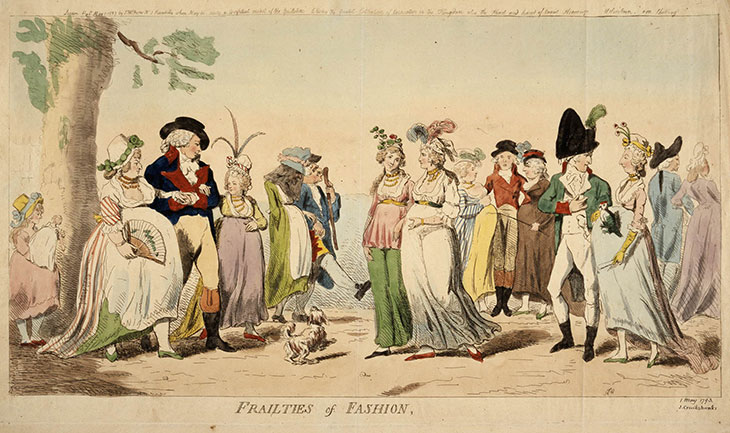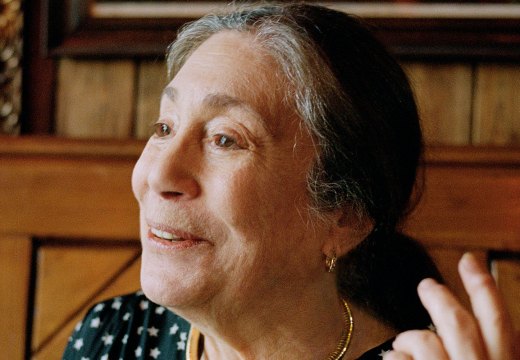It’s difficult to put together an exhibition about pregnancy, especially in the early modern period, without it becoming, in part, an exhibition about death. Although the curator Karen Hearn writes in the book that accompanies ‘Portraying Pregnancy: From Holbein to Social Media’ that her concern is exclusively with the pregnant body itself – ‘it barely deals with childbirth, or with the early motherhood that followed it, and it has little to say about foetuses and embryos’ – this focus on ‘the women themselves’ inevitably extends to the anxieties that surround the end of a pregnancy. The impressive material in the exhibition that deviates from its focus on portraiture primarily reinforces the mortality of the subjects: one of the anatomist William Hunter’s copperplate images of a dissected gravid womb; the original manuscript of Elizabeth Joscelin’s letter to her unborn child in 1622, which was published as a Mothers Legacie after she died of puerperal fever. Exhibited next to George Dawe’s famous 1817 portrait of George IV’s only child, Princess Charlotte, is the actual Russian-style sarafan dress she wears in the image: her death later that year after the botched delivery of her stillborn son led to the accession to the throne of Queen Victoria.
These material artefacts make tangible the anxiety of pregnancy at times when maternal mortality was a constant threat. Many of the earliest portraits included in the show, as the wall texts point out, were explicitly intended as pre-emptive memorialisations of their subjects. But the proliferation of stories about death across the extensive period covered by the exhibition is a reminder that maternal mortality is not synonymous with only with the distant past. James Cowie’s Self-portrait with the Artist’s First Wife (1923), for example, pictures Cowie next to his wife Nancy Buchanan, who died less than a year after the birth of their child. Nancy is depicted looking away into the middle distance, facing an easel and framed by a wall niche that makes her seem more portrait than woman. The painting is followed a few works later by Annie Leibovitz’s photograph from 2017 of Serena Williams, naked and heavily pregnant, who almost died after an emergency C-section. Perhaps it is always difficult to isolate the present, to detach the condition of pregnancy from its end result or product.

Cicely Heron (c. 1527), Hans Holbein the Younger. Royal Collection Trust/© Her Majesty Queen Elizabeth II 2019
Yet the artistic portrayal of gestation can’t help but be rooted in its immediate context. The overarching idea behind the exhibition was to offer ‘a new lens through which to look at history’, writes Hearn, and the display is structured chronologically, although there are a few larger pieces upstairs, including Augustus John’s Ida Pregnant (c. 1901), that are separate from the timeline. The earliest portrait included is Hans Holbein the Younger’s drawing of Sir Thomas More’s daughter, Cicely Heron (c. 1527), a then unique depiction of a pregnant woman sketched from life. Although pregnancy was a visible feature in many Tudor and early Stuart portraits, between the end of the 17th century and the end of the 20th century the representation of pregnancy was absorbed into the realms of the symbolic, the satirical (Isaac Cruikshank’s Frailties of Fashion, depicting the fashion for belly pads that sprung up in London in 1793), and the taboo: Victorian responses to the National Gallery’s acquisition of the Arnolfini portrait in 1842, at the time considered to depict a pregnant woman, condemned its lack of ‘moral purity’.

Frailties of Fashion (1793), Isaac Cruikshank, published by S.W. Fores, London, 16 April 1793. Photo: British Museum, London (Creative Commons)
Thematic links extend across the periods, in the imagery of blooming roses (Van Dyck, Lucian Freud), the repeated invocations of the biblical Annunciation, the move between Burne-Jones’ depiction of Julia Stephen pregnant with Vanessa Bell to Duncan Grant’s painting of Bell herself, but at times the ambitious timeline of the exhibition feels compressed and hurried. What the works gathered in ‘Portraying Pregnancy’ do demonstrate is how the response to the unsettling physical reminder of mortality and sexuality engendered by pregnant bodies changed: from the depiction of them, as in the earliest portraits, as affirmations of paternalistic structures of inheritance and power to the suppression of them – Hearn’s research uncovered almost no images at all from the Victorian period – to the recent ‘reclamation’ of the form. More time, however, could be spent on the shifting societal contexts of repression and control: race and class are mentioned only briefly, and sexuality not at all.
Hearn identifies the ‘watershed moment’ in the 20th-century documentation of pregnancy as Annie Leibovitz’s photograph of a naked, heavily pregnant Demi Moore on the cover of the August 1991 issue of Vanity Fair, which she reprised 26 years later with the image of Serena Williams, in the same year that Awol Erizku’s image of Beyoncé pregnant with twins became the most liked Instagram photograph of 2017. This is presented as symbolic of women taking ‘ownership’ not just of representations of their pregnant bodies, but also the distribution of their portraits. But what do we mean by ownership? Leibovitz’s photographs, however radical in their subject matter, conform to the glossy conventions of the commercial magazine. The restored prominence of pregnancy portraiture over the last 40 years is clearly linked to feminist art practice, which in itself is associated with self-portraiture that extends beyond the mediums we might traditionally consider to be representational. The decision not to include the wealth of conceptual and experimental visual and performance art in which artists have depicted their own pregnancies in this exhibition feels, therefore, like something of a missed opportunity.

Mary Tudor, Queen of England, Second Wife of Philip II (1554), Anthonis Mor. Museo del Prado, Madrid
The questions asked by artists like Susan Hiller, Catherine Elwes or Liv Pennington – whose Private View (2006), in which she asked strangers to take pregnancy tests and then displayed the result, was recently restaged in an exhibition at Richard Saulton Gallery called ‘Matrescence’ – about pregnancy, diagnosis, and self-representation are not so different from those asked by the more conventional portraiture in the show. The epistemological uncertainty of pregnancy as a state – one person containing two, a process that might not reach its end – is present already in the portrait of 1554 by Anthonis Mor of Mary I, in the middle of a pregnancy we now know to have been phantom, and in the figure of the Virgin Mary that recurs across the centuries.
‘Portraying Pregnancy: From Holbein to Social Media’ is at the Foundling Museum, London, until 26 April.














![Masterpiece [Re]discovery 2022. Photo: Ben Fisher Photography, courtesy of Masterpiece London](http://zephr.apollo-magazine.com/wp-content/uploads/2022/07/MPL2022_4263.jpg)
‘Like landscape, his objects seem to breathe’: Gordon Baldwin (1932–2025)